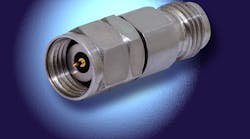Download this article in PDF format.
Wireless data requires frequency bandwidth, and the promise of emerging Fifth Generation (5G) wireless communications networks is that bandwidth will be available to transfer data within local area networks via millimeter-wave frequencies. Frequency bands above the microwave range are also being used for automotive radar systems. Such frequencies above 30 GHz now represent the part of the spectrum that can provide the bandwidth for these applications.
In support of millimeter-wave applications, Mini-Circuits has been cultivating a variety of affordable component families for frequency coverage to 40 GHz and beyond, including coaxial cable assemblies, power dividers/combiners, terminations, and adapters. In addition, for those faced with regulating signal power levels at these higher frequencies, the firm offers the BW-VX-1W54+ series of fixed attenuators, with available attenuation values of 3, 6, 10, and 20 dB for a broad bandwidth of dc to 50 GHz.
The precision coaxial attenuators (see figure) are well-suited for impedance-matching and level-setting applications in measurement systems. Each attenuator is equipped with a 2.4-mm male connector and a 2.4-mm female connector, with passivated stainless-steel connectors used for low loss and long-term durability. All of the attenuators typically handle maximum input power of 1 W (+30 dBm) at room temperature (+25ºC), with the power-handling capability derated linearly with temperature to 0.1 W at +100ºC. All are designed for an operating temperature range of ‒55 to +100ºC.
Pay Attention to Attenuator Specs
Regardless of the attenuation value selected, the performance levels are remarkably consistent across the broad frequency range, with minimal power reflected back to the source (low VSWR) and very little variation in attenuation. In terms of variation of attenuation with frequency, variations are typically less for units with higher attenuation values and less for all attenuations at higher frequencies.
The BW-VX-1W54+ series of fixed attenuators includes models with attenuation values of 3, 6, 10, and 20 dB across a broad bandwidth of dc to 50 GHz.
For example, model BW-V3-1W54+ is a 3-dB fixed attenuator that exhibits 3.0-dB typical attenuation from dc to 26.5 GHz, 3.4 dB typical attenuation from 26.5 to 40.0 GHz, and 3.8 dB typical attenuation from 40 to 50 GHz. It has VSWR of 1.10:1 from dc to 26.5 GHz, rising to 1.20:1 from 26.5 to 40.0 GHz, and then dropping to 1.10:1 from 40 to 50 GHz.
At twice the attenuation, model BW-V6-1W54+ is rated for 6-dB attenuation from dc to 50 GHz. It shows the greatest percentage attenuation variation for the four attenuation values, with typical attenuation of 5.8 dB from dc to 26.5 GHz, 6.1 dB from 26.5 to 40.0 GHz, and 6.6 dB from 40 to 50 GHz. Its typical VSWR is quite consistent, at 1.10:1 from dc to 26.5 GHz, remaining at typically 1.20:1 from 26.5 to 50.0 GHz.
Model BW-V10-1W54+ is a 10-dB fixed attenuator that features remarkably flat attenuation with frequency, typically 10.0 dB from dc to 26.5 GHz, 10.1 dB from 26.5 to 40.0 GHz, and 10.2 dB from 40 to 50 GHz. The VSWR is also consistent, typically a low 1.20:1 from dc to 26.5 GHz and then gradually rising to 1.50:1 from 26.5 to 50.0 GHz.
Model BW-V20-1W54+ is a 20-dB fixed attenuator that remains within 0.3 dB of its nominal attenuation value across the full 50-GHz bandwidth. The attenuation is typically 19.8 dB from dc to 26.5 GHz, 19.8 dB from 26.5 to 40 GHz, and 19.7 dB from 40 to 50 GHz. The VSWR for this model actually improves at higher frequencies, with typical VSWR of 1.20:1 from dc to 40 GHz, decreasing to a mere 1.10:1 from 40 to 50 GHz.
The attenuators measure 0.871 in. (22.12 mm) lengthwise with 0.360-in. (9.14 mm) diameter. Thanks to their broadband frequency coverage, they are well-suited for a number of different applications aimed at testing emerging 5G wireless communications networks as well as satellite-communications (satcom) networks. They represent the growing number of components being developed at Mini-Circuits for use through millimeter-wave frequencies, including coaxial cable assemblies, adapters, and power combiners/dividers.
Mini-Circuits, P. O. Box 350166, Brooklyn, NY 11235-003; (718) 934-4500, FAX: (718) 332-4661, www.minicircuits.com.


